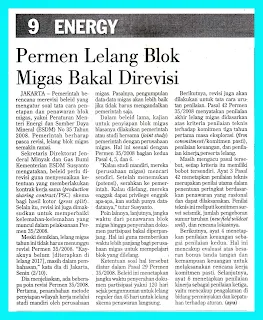The State Audit Board assessed that the commercial and gas transportation activities run by PT Pertamina Gas are still less effective. In the IHPS of Semester I / 2017 of the State Audit Agency (BPK), PT Pertamina Gas (Pertagas), has not run its business effectively.
There are two matters causing BPK to conclude Pertagas gas trading and transportation activities. The first gas transmission pipeline project of Belawan - Medan Industrial Area (KIM) - Special Economic Zone (KEK) that has not been completed. The project, which was supposed to be completed by September 2015, could not be completed due to the absence of gas buyers. Other causes, can not be completed the final calculation because it requires a contract amendment.
The length of the construction of the first pipe plot by President Joko Widodo has the potential to cause the financial burden of PT Pertamina Gas amounting to US $ 59.58 million and Rp 3 billion. Second, on the commercial trade of gas. Pertagas assumes a loss of revenue of US $ 16.57 million and the incidence of bad debts worth US $ 11.86 million due to depreciation of nominees, commercial schemes and operation of Pondok Tengah gas utilization which does not take into account operating conditions, as well as the transfer of gas allocation for compressed natural gas CNG) to PT Mutiara Energy.
"BPK concludes that in general the commercial and gas transportation activities at Pertagas are still less effective," quoted from IHPS BPK.
Contacted separately, Public Relations & Corporate Social Responsibility Manager Pertagas Hatim Ilwan said that his side has responded and followed up the recommendations of the BPK.
BPK recommends Pertagas to evaluate and establish procedures for determining the maximum number of stocks that entrust gas for distribution or shipper stock, transfer of nominations, and to make an acceptable collection effort of PT Mutiara Energy's bad debts.
Other recommendations are also proposed to rearrange feasibility studies and project economics based on real conditions and coordinate internally and externally so that Belawan-KIM-KEK pipeline assets can be utilized optimally.
"We at Pertagas have followed up the recommendations of the BPK and we have to say," he said.
Meanwhile, for Belawan-KIM-KEK construction project, he considered that it has been built since the beginning of 2016 along 138 kilometers. Belawan-KIM gas pipeline will be built with 18-inch diameter pipe having capacity of 89 million cubic feet per day (MMscfd).
IN INDONESIA
Bisnis Gas Pertagas Belum Efektif
Badan Pemeriksa Keuangan menilai kegiatan niaga dan transportasi gas yang dijalankan oleh PT Pertamina Gas masih kurang efektif. Dalam lkhtisar Hasil Pemeriksaan Sementara (IHPS) Semester I/2017 dari Badan Pemeriksa Keuangan (BPK), PT Pertamina Gas (Pertagas), belum menjalankan usaha secara efektif.
Terdapat dua hal yang menyebabkan BPK menyimpulkan kegiatan niaga dan transportasi gas Pertagas. Pertama proyek pipa gas transmisi ruas Belawan-Kawasan lndustri Medan (KIM)-Kawasan Ekonomi Khusus (KEK) yang belum rampung. Proyek yang seharusnya selesai pada September 2015 itu belum bisa diselesaikan karena belum adanya pembeli gas. Penyebab lainnya, belum bisa dilakukan penyelesaian kalkulasi tahap akhir karena memerlukan amendemen kontrak.
Lamanya pembangunan ruas pipa yang peletakan batu pertamanya dilakukan oleh Presiden Joko Widodo menyebabkan berpotensi menimbulkan beban keuangan PT Pertamina Gas sebesar US$ 59,58 juta dan Rp 3 miliar. Kedua, pada kegiatan niaga gas.
Pertagas menanggung kehilangan pendapatan US$ 16,57 juta dan timbulnya piutang macet senilai US$ 11,86 juta akibat penyusutan nominasi, skema niaga, dan operasi pemanfaatan gas Pondok Tengah yang tidak mempertimbangkan kondisi operasi, serta pengalihan alokasi gas untuk kebutuhan compressed natural gas (CNG) kepada PT Mutiara Energy.
“BPK menyimpulkan bahwa secara umum kegiatan niaga dan transportasi gas pada Pertagas masih kurang efektif,” dikutip dari IHPS BPK.
Dihubungi terpisah, Public Relations & Corporate Social Responsibility Manager Pertagas Hatim Ilwan mengatakan bahwa pihaknya telah merespons dan menindaklanjuti rekomendasi dari BPK.
BPK merekomendasikan agar Pertagas melakukan evaluasi dan menetapkan prosedur penentuan jumlah maksimum stok pihak yang menitipkan gas untuk disalurkan atau shipper stock, pengalihan nominasi, dan melakukan upaya penagihan terhitung piutang macet PT Mutiara Energy.
Rekomendasi lain yang juga diusulkan menyusun ulang studi kelayakan dan keekonomian proyek berdasarkan kondisi yang riil serta berkoordinasi dengan internal dan eksternal agar aset pipa Belawan-KIM-KEK dapat dimanfaatkan secara optimal.
“Kami di Pertagas sudah melakukan tindak lanjut atas rekomendasi dari BPK dan kami sudah sampaikan,” ujarnya.
Sementara itu, untuk proyek pembangunan ruas Belawan-KIM-KEK, dia menilai sudah terbangun sejak awal 2016 sepanjang 138 kilometer. Pipa gas ruas Belawan-KIM bakal dibangun dengan diameter pipa 18 inci memiliki kapasitas 89 juta kaki kubik per hari (MMscfd).
Bisnis Indonesia, Page-30, Thursday, October 5, 2017









